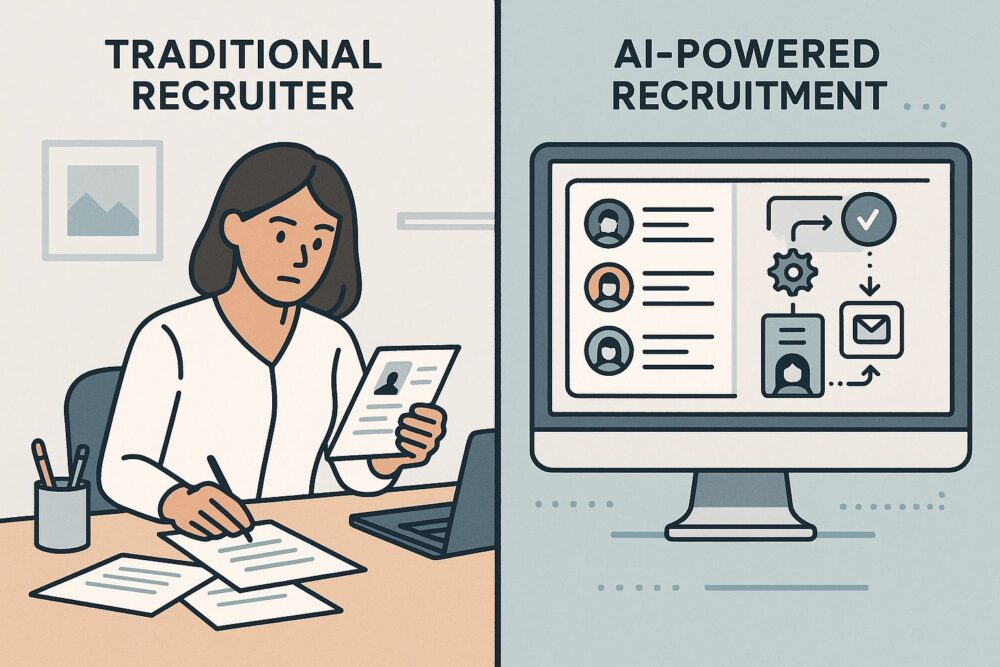Global Skills Shortage 2025 Talent Crisis Solutions
Global Skills Shortage: The global skills shortage reaches critical proportions in 2025, with 77% of employers worldwide reporting difficulty filling positions due to talent scarcity across multiple industries and skill categories. This unprecedented crisis demands innovative solutions that transcend traditional recruitment approaches while addressing fundamental mismatches between available talent and market demands.
Global Skills Shortage: Understanding the scope and complexity of global talent shortages becomes essential for organizations seeking to maintain competitive advantages and operational continuity. The convergence of demographic shifts, technological advancement, and economic transformation creates perfect storm conditions that require strategic, multi-faceted responses from employers and policymakers alike.
Global Skills Shortage: Successful organizations are those that proactively develop comprehensive talent strategies combining international recruitment, skills development, technology integration, and workforce transformation initiatives. These approaches not only address immediate staffing needs but also build sustainable competitive advantages for long-term success.
Global Skills Shortage: Understanding the Global Skills Crisis
Global Skills Shortage: The worldwide talent shortage affects every continent and industry with particularly acute shortages in technology, healthcare, skilled trades, and professional services sectors where demand significantly exceeds qualified candidate supply.
Critical Statistics and Scope
Industry Impact Analysis
- Technology sector: 4.3 million unfilled positions globally
- Healthcare: 15 million healthcare worker deficit by 2030
- Manufacturing: 2.1 million skilled worker shortage
- Construction: 430,000 skilled trade positions vacant
- Financial services: 1.2 million cybersecurity roles unfilled
Geographic Distribution Developed economies experience the most severe shortages due to aging populations and high skill requirements, while emerging markets face different challenges related to education access and brain drain.
Economic Consequences Skills shortages cost the global economy an estimated $8.5 trillion annually in lost productivity, delayed projects, and reduced innovation capacity.
Root Causes and Contributing Factors
Demographic Transitions Aging populations in developed countries create retirement waves that exceed new entrant rates, particularly in specialized technical and professional roles.
Technology Disruption Rapid technological advancement creates demand for new skills faster than educational systems and workforce development programs can supply qualified candidates.
Educational Misalignment Gap between educational curriculum and industry requirements leads to graduates lacking practical skills needed for available positions.
Geographic Mobility Restrictions Immigration policies and mobility barriers prevent optimal global talent distribution to address regional shortages.
Sector-Specific Shortage Analysis
Technology and Digital Skills Crisis
Global Skills Shortage:
Software Development and Engineering Global skills shortage of 4.3 million software developers with particular scarcity in specialized areas including artificial intelligence, machine learning, and cybersecurity. global people.
Data Science and Analytics Organizations struggle to find qualified data scientists, business analysts, and AI specialists capable of extracting insights from growing data volumes.
Cybersecurity Professionals Critical shortage of cybersecurity experts as organizations face increasing threat landscapes and regulatory compliance requirements.
Cloud and Infrastructure Specialists Migration to cloud computing creates demand for specialists in cloud architecture, DevOps, and infrastructure management that exceeds supply.
Healthcare Professional Shortages
Medical Practitioners Global shortage of 15 million healthcare workers by 2030 including physicians, nurses, and specialized medical professionals across all practice areas. Tech talent shortage.
Mental Health Specialists Acute shortage of mental health professionals as awareness and demand for psychological services increases dramatically worldwide.
Healthcare Technology Specialists Growing need for professionals combining medical knowledge with technology expertise for digital health transformation initiatives.
Elderly Care Specialists Aging global population creates unprecedented demand for geriatric specialists and elderly care professionals.
Skilled Trades and Manufacturing
Advanced Manufacturing Technicians Industry 4.0 transformation requires technicians skilled in automation, robotics, and smart manufacturing technologies that traditional training programs haven’t addressed.
Renewable Energy Specialists Clean energy transition creates demand for wind turbine technicians, solar installation specialists, and grid modernization experts.
Construction and Infrastructure Major infrastructure projects worldwide face delays due to shortages of skilled electricians, plumbers, heavy equipment operators, and project managers.
Maintenance and Repair Specialists Complex modern equipment requires specialized maintenance skills that combine traditional mechanical knowledge with digital diagnostics.
Strategic Solutions for Talent Acquisition
International Recruitment and Mobility
Global Skills Shortage:
Global Talent Sourcing Systematic identification and recruitment of talent from international markets with surplus skilled workers in required specializations.
Cross-Border Talent Programs Development of structured programs facilitating international talent mobility including visa sponsorship, relocation support, and cultural integration assistance.
Diaspora Engagement Reconnecting with skilled diaspora populations who may be willing to return to home countries or work remotely for domestic organizations.
Emerging Market Partnerships Strategic partnerships with educational institutions and professional organizations in emerging markets with growing talent pools.
Skills-Based Hiring Evolution
Competency-Focused Assessment Shifting from credential-based to competency-based hiring that evaluates actual skills rather than formal qualifications or traditional experience patterns.
Portfolio and Project-Based Evaluation Assessment methods emphasizing demonstrated capabilities through portfolios, practical projects, and real-world problem-solving exercises.
Apprenticeship and On-the-Job Training Expansion of apprenticeship programs and structured on-the-job training that develop required skills while filling immediate staffing needs.
Micro-Credential Recognition Recognition of micro-credentials, professional certifications, and alternative learning pathways that demonstrate specific competencies.
Workforce Development and Training Solutions
Corporate Training and Upskilling
Global Skills Shortage:
Internal Talent Development Comprehensive internal training programs that develop existing employees for higher-skill positions while creating advancement pathways.
Cross-Training and Skill Expansion Strategic cross-training initiatives that broaden employee skill sets while creating operational flexibility and redundancy.
Partnership with Educational Institutions Collaboration with universities and training providers to create customized education programs addressing specific organizational skill needs.
Mentorship and Knowledge Transfer Structured mentorship programs that facilitate knowledge transfer from experienced professionals to developing talent.
Technology-Enhanced Learning
AI-Powered Personalized Training Artificial intelligence systems that customize training content and pace based on individual learning styles and skill development needs.
Virtual and Augmented Reality Training Immersive training technologies that provide hands-on experience in safe, controlled environments for high-risk or expensive training scenarios.
Microlearning and Just-in-Time Training Bite-sized learning modules that provide specific skills training when needed without disrupting work schedules.
Collaborative Learning Platforms Online platforms that facilitate peer learning, expert knowledge sharing, and community-based skill development.
Technology Solutions and Automation
Intelligent Automation Integration
Global Skills Shortage:
Process Automation Implementation Strategic automation of routine tasks that frees human workers for higher-value activities requiring creativity and complex problem-solving.
AI-Augmented Human Performance Integration of artificial intelligence tools that enhance human capabilities rather than replace workers, improving productivity and decision-making.
Robotic Process Automation (RPA) Implementation of RPA systems that handle repetitive tasks while humans focus on strategic and relationship-building activities.
Predictive Analytics for Workforce Planning Advanced analytics that predict skill demands and identify potential shortages before they become critical operational issues.
Human-Machine Collaboration
Augmented Intelligence Systems Development of systems that combine human intuition and creativity with machine processing power and data analysis capabilities.
Collaborative Robotics (Cobots) Implementation of collaborative robots that work alongside human workers, enhancing productivity while maintaining human oversight and creativity.
Digital Assistant Integration AI-powered digital assistants that support human workers by providing information, automating routine tasks, and facilitating decision-making.
Smart Workflow Optimization Intelligent systems that optimize workflows and task allocation based on human skills, preferences, and machine capabilities.
Alternative Workforce Models
Flexible Employment Strategies
Global Skills Shortage:
Gig Economy Integration Strategic utilization of gig workers and freelancers to access specialized skills on-demand while maintaining core permanent workforce.
Project-Based Staffing Flexible staffing models that bring together specialized talent for specific projects while avoiding long-term employment commitments.
Consultancy and Advisory Relationships Engagement of independent consultants and advisors who provide specialized expertise without full-time employment relationships.
Shared Talent Pools Collaborative arrangements between organizations to share access to specialized talent pools, reducing individual recruitment costs.
Remote and Distributed Work
Global Remote Talent Access Leveraging remote work capabilities to access global talent pools without geographic restrictions or relocation requirements.
Distributed Team Management Development of management capabilities for leading distributed teams across time zones and cultural boundaries.
Digital Nomad Programs Structured programs that attract digital nomads and location-independent professionals to address skill shortages.
Hybrid Work Optimization Optimization of hybrid work models that balance flexibility with collaboration and productivity requirements.
Public-Private Partnership Solutions
Government Collaboration
Global Skills Shortage:
Immigration Policy Reform Advocacy for immigration policy reforms that facilitate skilled worker mobility while addressing legitimate security and economic concerns.
Education System Alignment Collaboration with governments to align educational curricula with industry needs and future skill requirements.
Infrastructure Investment Public-private partnerships that invest in infrastructure supporting talent development and economic growth.
Regional Development Programs Programs that address regional development needs while creating opportunities for skilled employment and economic advancement.
Industry Consortium Approaches
Sector-Wide Training Initiatives Industry consortiums that pool resources for large-scale training programs addressing common skill shortages.
Standards and Certification Development Collaborative development of industry standards and certification programs that ensure consistent skill quality.
Research and Development Collaboration Joint research initiatives that advance knowledge while developing practical skills and capabilities.
Policy Advocacy and Reform Collective advocacy for policy reforms that support talent development and mobility while addressing skills shortages.
Measuring Success and ROI
Key Performance Indicators
Global Skills Shortage:
Time-to-Fill Metrics Tracking improvements in position filling times as talent shortage solutions are implemented and optimized.
Quality of Hire Measurements Assessing the performance and retention of talent acquired through alternative sourcing and development methods.
Cost-Per-Hire Analysis Comprehensive cost analysis including recruitment, training, and integration expenses for different talent acquisition strategies.
Productivity and Performance Impact Measuring productivity improvements and business outcomes resulting from successful talent shortage mitigation strategies.
Long-Term Strategic Assessment
Skill Development Pipeline Analysis Evaluation of talent development pipeline effectiveness in meeting future skill requirements and organizational growth.
Competitive Advantage Measurement Assessment of competitive advantages gained through superior talent acquisition and development capabilities.
Innovation and Growth Impact Measurement of innovation capacity and growth achievements enabled by successful talent shortage resolution.
Stakeholder Satisfaction Evaluation Assessment of employee, customer, and stakeholder satisfaction with talent strategy outcomes and organizational capabilities.
Future Trends and Predictions
Evolving Skill Requirements
Global Skills Shortage:
Emerging Technology Skills Anticipation of new skill requirements emerging from quantum computing, biotechnology, and advanced artificial intelligence.
Hybrid Skill Combinations Growing demand for professionals with hybrid skills combining technical expertise with business acumen and cultural intelligence.
Sustainability and ESG Competencies Increasing importance of sustainability knowledge and ESG competencies across all roles and industries.
Digital Fluency and Adaptability Universal requirement for digital fluency and adaptability as technology continues transforming work environments.
Workforce Transformation Trends
Continuous Learning Culture Evolution toward continuous learning cultures where skill development becomes ongoing rather than episodic.
Personalized Career Development AI-powered personalized career development that optimizes individual growth paths while meeting organizational needs.
Cross-Industry Skill Transfer Increased recognition of transferable skills enabling talent mobility across industries and sectors.
Purpose-Driven Employment Growing importance of purpose and meaning in work as factors influencing talent attraction and retention.
Conclusion: Building Resilient Talent Strategies
The global skills shortage 2025 demands innovative, multi-faceted approaches that combine international recruitment, workforce development, technology integration, and alternative employment models. Organizations that address these challenges proactively gain sustainable competitive advantages while contributing to broader economic development.
Global Skills Shortage: Success requires commitment to long-term talent strategy development rather than short-term fixes, investment in comprehensive solutions rather than isolated tactics, and collaboration across organizational and geographic boundaries. The stakes are too high for incremental approaches transformational change is necessary.
Global Skills Shortage: The organizations that thrive in this challenging environment are those that view talent shortage as an opportunity to innovate, differentiate, and build capabilities that competitors cannot easily replicate. The investment in comprehensive talent strategy pays dividends through improved performance, competitive positioning, and organizational resilience.
Global Skills Shortage: Your organization’s future depends on developing talent strategies that address current shortages while building capabilities for continued success in an evolving global economy. The time for action is now—the cost of inaction grows with every day of delay.



